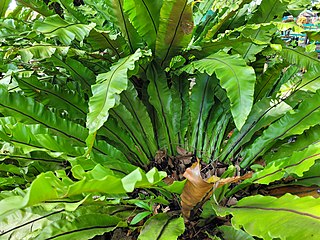
Asplenium nidus is an epiphytic species of fern in the family Aspleniaceae, native to tropical southeastern Asia, eastern Australia, Hawaii, Polynesia, Christmas Island, India, and eastern Africa. It is known by the common names bird's-nest fern or simply nest fern.
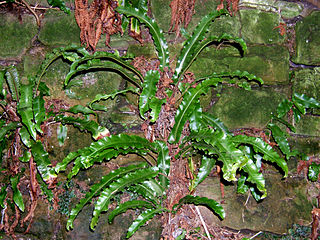
Asplenium scolopendrium, commonly known as the hart's-tongue fern, is an evergreen fern in the family Aspleniaceae native to the Northern Hemisphere.
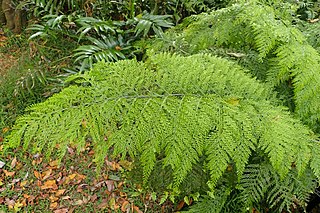
Asplenium bulbiferum, known as mother spleenwort, is a fern species native to New Zealand only. It is also called hen and chicken fern and, in the Māori language, pikopiko, mouku or mauku. Its fronds are eaten as a vegetable.

Asplenium rhizophyllum, the (American) walking fern, is a frequently-occurring fern native to North America. It is a close relative of Asplenium ruprechtii which is found in East Asia and also goes by the common name of "walking fern".

Asplenium ceterach is a fern species commonly known as rustyback.

Asplenium septentrionale is a species of fern known by the common names northern spleenwort and forked spleenwort. It is native to Europe, Asia and western North America, where it grows on rocks. Its long, slender leaves give it a distinctive appearance. Three subspecies exist, corresponding to a tetraploid and a diploid cytotype and their triploid hybrid.

Asplenium vespertinum is a species of fern known by the common name western spleenwort. It is native to southern California and Baja California, where it grows in moist, shady, rocky places, such as the shadows beneath cliff overhangs.

Asplenium australasicum, the bird's nest fern or crow's nest fern, is an epiphytic Australasian species of fern in the family Aspleniaceae.

Asplenium antiquum is a fern of the group known as bird's-nest ferns. In Japanese it is known by ō-tani-watari and tani-watari. It grows on cliffs, in dark forests, and on tree trunks in China, Japan, Korea, and Taiwan. It is classified as an endangered species in both South Korea and Japan.

Asplenium ruta-muraria is a species of fern commonly known as wall-rue. It is a very small epipetric species, growing exclusively on limestone and other calcareous rocks. Its fronds are bluish-green and are heavily sub-divided, becoming up to 12 cm in length.
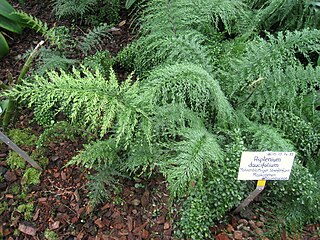
Asplenium daucifolium is a species of fern in the family Aspleniaceae, endemic to the Mascarene Islands.

Asplenium anceps is a diploid fern of family Aspleniaceae and one of the ancestors of the ferns that form the trichomanes complex. It lives exclusively in the three northernmost archipelagoes of the Macaronesian region, that is, is an endemic macaronesian fern. Its fronds are leathery and plastic and rachis is very thick, bright reddish brown and is traversed throughout its length of three wings, two on the upper surface to draw a groove and a third on the lower surface which is characteristic and unique to this species, since all other species of the trichomanes complex without. A typical feature of this fern, which he shares with all its hybrid offspring is the existence of a small atrium on the basis of medium and less pinnae directed toward the apex of the blade with one or two sori on its underside.

Asplenium goudeyi is a fern only found on Lord Howe Island. A common plant growing in a variety of situations. On trees, or rocks, boulders, cliff faces and sometimes in exposed positions. The wavy edged fronds are 50 to 75 cm long, and 12 to 18 cm wide.

Asplenium viride is a species of fern known as the green spleenwort because of its green stipes and rachides. This feature easily distinguishes it from the very similar-looking maidenhair spleenwort, Asplenium trichomanes.

Asplenium oblongifolium is a native species of fern from New Zealand. The plant's common name is shining spleenwort and its Māori name is huruhuruwhenua. A. oblongifolium is found on the North, South, Chatham and Kermadec Islands, and is found from the coast to the mountains.

Asplenium milnei is a ground fern only found on Lord Howe Island. Commonly seen in lowland areas.

Asplenium difforme is a plant in the spleenwort group of ferns. Its habitat is cracks in rocky headlands beside the sea. It is found in eastern Australia and Norfolk Island. Its fronds are thick and waxy to protect it from sea spray.

Asplenium appendiculatum, ground spleenwort, is a common native fern to Australia and New Zealand. It usually grows in cool damp conditions, among rocks, on logs or as an epiphyte.
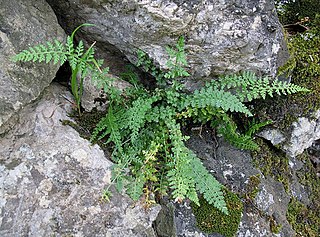
Asplenium fontanum, commonly known as fountain spleenwort or smooth rock spleenwort, is a species of fern in the family Aspleniaceae, native to rocky areas in Western Europe.
Asplenium haughtonii, also known as the Barn fern, is a species of fern in the family Aspleniaceae. It is native to Saint Helena.



















